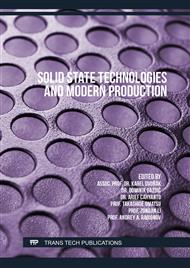[1]
E.S. Ahn, N.J. Gleason, J.Y. Ying. The effect of zirconia reinforcing agents on the microstructure and mechanical properties of hydroxyapatite-based nanocomposites. J Am Ceram Soc. (2005);88(12):3374-3379.
DOI: 10.1111/j.1551-2916.2005.00636.x
Google Scholar
[2]
B. Cales, J. M. Drouin. Low-Temperature Aging of Y-TZP Ceramics. (1999); 54:2150-2154.
Google Scholar
[3]
V. Lughi, V. Sergo. Low temperature degradation -aging- of zirconia: A critical review of the relevant aspects in dentistry. Dent Mater. (2010);26(8):807-820.
DOI: 10.1016/j.dental.2010.04.006
Google Scholar
[4]
K.I. Afrashtehfar; M. Del Fabbro. Clinical performance of zirconia implants: A meta-review. J. Prosthet. Dent. (2020), 123, 419–426.
DOI: 10.1016/j.prosdent.2019.05.017
Google Scholar
[5]
A. J. Raigrodski. Contemporary materials and technologies for all-ceramic fixed partial dentures: A review of the literature. J. Prosthet. Dent. (2004), 92, 557–562.
DOI: 10.1016/j.prosdent.2004.09.015
Google Scholar
[6]
I. Denry.; J.R. Kelly. State of the art of zirconia for dental applications. Dent. Mater. (2008), 24, 299–307.
DOI: 10.1016/j.dental.2007.05.007
Google Scholar
[7]
P. C. Guess, R.A. Zavanelli, N.R.F.A. Silva, E.A. Bonfante, P.G. Coelho, V.P. Thompson. Monolithic CAD/CAM lithium disilicate versus veneered Y-TZP crowns: comparison of failure modes and reliability after fatigue. Int J Prosthodont. (2010);23(5):434-442.
Google Scholar
[8]
Y. Xu, J. Han, H. Lin, L. An. Comparative study of flexural strength test methods on CAD/CAM Y-TZP dental ceramics. Regen Biomater. (2015);2(4):239-244.
DOI: 10.1093/rb/rbv020
Google Scholar
[9]
K. Tanaka, J. Tamura, K. Kawanabe, M. Nawa, M. Oka, M. Uchida, et al. Ce-TZP/Al2O3 nanocomposite as a bearing material in total joint replacement. J Biomed Mater Res. (2002);63(3):262–70.
DOI: 10.1002/jbm.10182
Google Scholar
[10]
A. I. Hussein, A. N. C. Mat, N. A. A. Abd Wahab, A. b. Rahman I, A. Husein, Z. Ab-Ghani. Synthesis and properties of novel calcia-stabilized zirconia (Ca-SZ) with nano calcium oxide derived from cockle shells and commercial source for dental application. Appl Sci. (2020);10(17).
DOI: 10.3390/app10175751
Google Scholar
[11]
A. I. Hussein, Z. Ab-Ghani, A. N. C. Mat, N. A. A. Ghani, A. Husein, I. A. Rahman. Synthesis and characterization of spherical calcium carbonate nanoparticles derived from cockle shells. Appl Sci. (2020);10(20):1-14.
DOI: 10.3390/app10207170
Google Scholar
[12]
N. Xuan, T. Tram. Synthesis and Characterization of Calcite Nano-Particle Derived from Cockle Shell for Clinical Application. (2020);10(1):49-54.
DOI: 10.11113/aej.v10.15538
Google Scholar
[13]
A.I. Hussein, Synthesis of Nano Calcium Oxide from Cockle Shells as Stabilizer for Fabrication of Zirconia. Ph.D. Thesis, Pusat Pengajian Sains Pergigian, Universiti Sains Malaysia, Penang, Malaysia, (2018).
DOI: 10.17576/geo-2020-1604-20
Google Scholar
[14]
L. Hu C.-A. Wang, Effect of sintering temperature on compressive strength of porous yttria stabilized zirconia ceramics. Ceram. Int. (2010), 36, 1697–1701.
DOI: 10.1016/j.ceramint.2010.03.009
Google Scholar
[15]
R. Benzaid, J. Chevalier, M. Saâdaoui, G. Fantozzi, M. Nawa, L.A. Diaz, R. Torrecillas, Fracture toughness, strength and slow crack growth in a ceria stabilized zirconia–alumina nanocomposite for medical applications. Biomaterials (2008), 29, 3636–3641.
DOI: 10.1016/j.biomaterials.2008.05.021
Google Scholar
[16]
S. Fathiyah, S. Mohamad, S. Mohamad, Z. Jemaat. Study of calcination condition on decomposition of calcium carbonate in waste cockle shell to calcium oxide using thermal gravimetric analysis (2016);11 (16):9917-9921.
Google Scholar
[17]
S. Bano, S. Pillai, Green synthesis of calcium oxide nanoparticles at different calcination temperatures. World J Sci Technol Sustain Dev. (2020);283-295.
DOI: 10.1108/wjstsd-12-2019-0087
Google Scholar
[18]
S. M. Cokic, J. Vleugels, B. V. Meerbeek, et al. Mechanical properties, aging stability and translucency of speed-sintered zirconia for chairside restorations. Dent Mater. (2020);36(7):959-972.
DOI: 10.1016/j.dental.2020.04.026
Google Scholar
[19]
N. C. Lawson, R. Bansal, J. O. Burgess. Wear, strength, modulus and hardness of CAD/CAM restorative materials. Dent Mater. (2016);32(11):275-283.
DOI: 10.1016/j.dental.2016.08.222
Google Scholar
[20]
M. M. Mailafiya, K. Abubakar, A. Danmaigoro, et al. Cockle shell-derived calcium carbonate (aragonite) nanoparticles: A dynamite to nanomedicine. Appl Sci. (2019);9(14):1-25.
DOI: 10.3390/app9142897
Google Scholar
[21]
A. S. Kamba, M. Ismail, T. A. Tengku Ibrahim, Z. A. B. Zakaria. Synthesis and characterisation of calcium carbonate aragonite nanocrystals from cockle shell powder (Anadara granosa). J Nanomater. (2013);(2013).
DOI: 10.1155/2013/398357
Google Scholar
[22]
M. Mohamed, S. Yousuf, S. Maitra. Decomposition study of calcium carbonate in cockle shell. J Eng Sci Technol. (2012);7(1):1-10.
Google Scholar
[23]
Y. Li, C. Zhao, H. Chen, L. Duan, X. Chen. CO2 capture behavior of shell during calcination/carbonation cycles. Chem Eng Technol. (2009);32(8):1176-1182.
DOI: 10.1002/ceat.200900008
Google Scholar
[24]
Z. E. Erkmen, Y. Genç, F. N. Oktar. Microstructural and mechanical properties of hydroxyapatite-zirconia composites. J Am Ceram Soc. (2007);90(9):2885-2892.
DOI: 10.1111/j.1551-2916.2007.01849.x
Google Scholar
[25]
J. Pihlaja, R. Näpänkangas, A. Raustia. Early complications and short-term failures of zirconia single crowns and partial fixed dental prostheses. J Prosthet Dent. (2014);112(4):778– 83.
DOI: 10.1016/j.prosdent.2014.03.008
Google Scholar
[26]
N. M. Beekmans, L. Heyne. Correlation between impedance, microstructure and composition of calcia-stabilized zirconia. Electrochim Acta. (1976);21(4):303-310.
DOI: 10.1016/0013-4686(76)80024-2
Google Scholar



